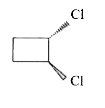Which of the following compounds is optically inactive?




The correct Answer is:B
To determine which of the given compounds is optically inactive, we need to identify the presence of chiral centers in each compound. A compound is optically inactive if it does not have a chiral carbon atom, which is defined as a carbon atom that is bonded to four different substituents.
1. Understand Optical Activity:
- Optical activity is a property of chiral compounds that can rotate plane-polarized light. Chiral compounds have at least one chiral carbon atom, which is a carbon atom bonded to four different groups.
2. Identify Chiral Centers:
- For each compound provided, we will analyze the carbon atoms to see if any of them are chiral. A chiral carbon must have four different substituents.
3. Analyze Each Compound:
- Compound 1: Check for symmetry and chiral centers.
- Upon examination, we find that this compound does not have any carbon atom with four different substituents. Therefore, it is likely to be optically inactive.
- Compound 2: Check for symmetry and chiral centers.
- This compound shows symmetry. If we divide it, we can see that it has two identical halves, indicating that it does not have a chiral center. Thus, it is optically inactive.
- Compound 3: Check for symmetry and chiral centers.
- In this compound, every carbon atom is bonded to different groups. Thus, it contains chiral centers and is optically active.
- Compound 4: Check for symmetry and chiral centers.
- Similar to compound 3, this compound also has chiral centers due to the presence of different substituents on the carbon atoms, making it optically active.
4. Conclusion:
- From the analysis, we find that Compound 2 is the only compound that is optically inactive due to its symmetry and lack of chiral centers.
Final Answer:
The compound that is optically inactive is Compound 2.
- Optical activity is a property of chiral compounds that can rotate plane-polarized light. Chiral compounds have at least one chiral carbon atom, which is a carbon atom bonded to four different groups.
- For each compound provided, we will analyze the carbon atoms to see if any of them are chiral. A chiral carbon must have four different substituents.
- Compound 1: Check for symmetry and chiral centers.
- Upon examination, we find that this compound does not have any carbon atom with four different substituents. Therefore, it is likely to be optically inactive.
- Compound 2: Check for symmetry and chiral centers.
- This compound shows symmetry. If we divide it, we can see that it has two identical halves, indicating that it does not have a chiral center. Thus, it is optically inactive.
- Compound 3: Check for symmetry and chiral centers.
- In this compound, every carbon atom is bonded to different groups. Thus, it contains chiral centers and is optically active.
- Compound 4: Check for symmetry and chiral centers.
- Similar to compound 3, this compound also has chiral centers due to the presence of different substituents on the carbon atoms, making it optically active.
- From the analysis, we find that Compound 2 is the only compound that is optically inactive due to its symmetry and lack of chiral centers.
The compound that is optically inactive is Compound 2.
Similar Questions
Knowledge Check
Which of the following compound is optically inactive ?
ACH3⋅CHOH⋅CH2⋅CH3BH2C=CH⋅CH2⋅CH=CH2C D
D
Which of the following compounds is optically active?
A B
B C
C D
D
Which of the following compounds is optically active?
A B
B C
C D
D
Which of the following amino acid is optically inactive?
View SolutionWhich of the following compound may be optical active ?
View SolutionWhich of the following compounds is optically active ?
View SolutionWhich of the following compounds are optically inactive but exhibit geometrical isomerism?
View SolutionWhich of the following compounds will be optically active?
View Solution

